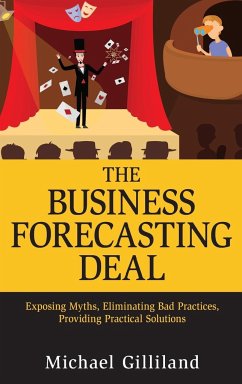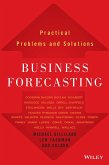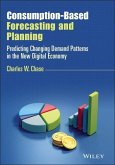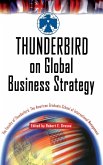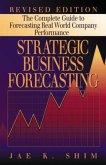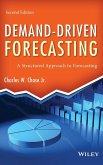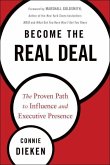Michael Gilliland
The Business Forecasting Deal
Exposing Myths, Eliminating Bad Practices, Providing Practical Solutions
Michael Gilliland
The Business Forecasting Deal
Exposing Myths, Eliminating Bad Practices, Providing Practical Solutions
- Gebundenes Buch
- Merkliste
- Auf die Merkliste
- Bewerten Bewerten
- Teilen
- Produkt teilen
- Produkterinnerung
- Produkterinnerung
Practical-nontechnical-solutions to the problems of business forecasting Written in a nontechnical style, this book provides practical solutions to common business forecasting problems, showing you how to think about business forecasting in the context of uncertainty, randomness and process performance. * Addresses the philosophical foundations of forecasting * Raises awareness of fundamental issues usually overlooked in pursuit of the perfect forecast * Introduces a new way to think about business forecasting, focusing on process efficiency and the elimination of worst practices * Provides…mehr
Andere Kunden interessierten sich auch für
![Business Forecasting Business Forecasting]() Michael GillilandBusiness Forecasting40,99 €
Michael GillilandBusiness Forecasting40,99 €![Consumption-Based Forecasting and Planning Consumption-Based Forecasting and Planning]() Charles W. ChaseConsumption-Based Forecasting and Planning39,99 €
Charles W. ChaseConsumption-Based Forecasting and Planning39,99 €![Thunderbird on Global Business Strategy Thunderbird on Global Business Strategy]() The Faculty of Thunderbird the American Graduate School of International ManagementThunderbird on Global Business Strategy56,99 €
The Faculty of Thunderbird the American Graduate School of International ManagementThunderbird on Global Business Strategy56,99 €![Strategic Business Forecasting Strategic Business Forecasting]() Jae K ShimStrategic Business Forecasting187,99 €
Jae K ShimStrategic Business Forecasting187,99 €![Forecasting 2E (SAS) Forecasting 2E (SAS)]() Charles W. ChaseForecasting 2E (SAS)75,99 €
Charles W. ChaseForecasting 2E (SAS)75,99 €![Busting Loose from the Business Game Busting Loose from the Business Game]() Robert ScheinfeldBusting Loose from the Business Game20,99 €
Robert ScheinfeldBusting Loose from the Business Game20,99 €![Become the Real Deal Become the Real Deal]() Connie DiekenBecome the Real Deal24,99 €
Connie DiekenBecome the Real Deal24,99 €-
-
-
Practical-nontechnical-solutions to the problems of business forecasting Written in a nontechnical style, this book provides practical solutions to common business forecasting problems, showing you how to think about business forecasting in the context of uncertainty, randomness and process performance. * Addresses the philosophical foundations of forecasting * Raises awareness of fundamental issues usually overlooked in pursuit of the perfect forecast * Introduces a new way to think about business forecasting, focusing on process efficiency and the elimination of worst practices * Provides practical approaches for the non-statistical problems forecasters face * Illustrates Forecast Value Added (FVA) Analysis for identifying waste in the forecasting process Couched in the context of uncertainty, randomness, and process performance, this book offers new, innovative ideas for resolving your business forecasting problems.
Hinweis: Dieser Artikel kann nur an eine deutsche Lieferadresse ausgeliefert werden.
Hinweis: Dieser Artikel kann nur an eine deutsche Lieferadresse ausgeliefert werden.
Produktdetails
- Produktdetails
- Verlag: John Wiley & Sons / Wiley
- Artikelnr. des Verlages: 14557443000
- Seitenzahl: 272
- Erscheinungstermin: 8. Juni 2010
- Englisch
- Abmessung: 235mm x 157mm x 19mm
- Gewicht: 554g
- ISBN-13: 9780470574430
- ISBN-10: 0470574437
- Artikelnr.: 28955205
- Herstellerkennzeichnung
- Libri GmbH
- Europaallee 1
- 36244 Bad Hersfeld
- gpsr@libri.de
- Verlag: John Wiley & Sons / Wiley
- Artikelnr. des Verlages: 14557443000
- Seitenzahl: 272
- Erscheinungstermin: 8. Juni 2010
- Englisch
- Abmessung: 235mm x 157mm x 19mm
- Gewicht: 554g
- ISBN-13: 9780470574430
- ISBN-10: 0470574437
- Artikelnr.: 28955205
- Herstellerkennzeichnung
- Libri GmbH
- Europaallee 1
- 36244 Bad Hersfeld
- gpsr@libri.de
MICHAEL GILLILAND is Product Marketing Manager at SAS Institute and has worked in consu-mer products forecasting for more than twenty years. Prior to joining SAS in 2004, Mike held forecasting management positions in the food, electronics, and apparel industries and served as a consultant. He is a frequent speaker at industry events, has published articles in Supply Chain Management Review, Journal of Business Forecasting, Foresight, and APICS magazine, and was a columnist on "Worst Practices in Business Forecasting" for Supply Chain Forecasting Digest. Mike holds a BA in philosophy from Michigan State University, and master's degrees in philosophy and mathematical sciences from Johns Hopkins University. Follow his blog, The Business Forecasting Deal, at blogs.sas.com/forecasting.
Foreword-Tom Wallace xiii
Foreword-Anne G. Robinson xv
Acknowledgments xvii
Prologue 1
Chapter 1 Fundamental Issues in Business Forecasting 5
The Problem of Induction 5
The Realities of Business Forecasting 6
The Contest 7
What Is Demand? 10
Constrained Forecast 13
Demand Volatility 15
Inherent Volatility and Artificial Volatility 17
Evils of Volatility 19
Evaluating Forecast Performance 22
Embarking on Improvement 24
Notes 26
Chapter 2 Worst Practices in Business Forecasting: Part 1 29
Worst Practices in the Mechanics of Forecasting 30
Model "Overfitting" and "Pick-Best" Selection 32
Confusing Model Fit with Forecast Accuracy 41
Accuracy Expectations and Performance Goals 43
Failure to Use a Naïve Model or Assess Forecast Value Added 47
Forecasting Hierarchies 48
Outlier Handling 50
Notes 54
Chapter 3 Worst Practices in Business Forecasting: Part 2 55
Worst Practices in the Process and Practices of Forecasting 55
Politics of Forecasting 57
Blaming the Forecast 60
Adding Variation to Demand 61
Evangelical Forecasting 64
Overinvesting in the Forecasting Function 66
Forecasting Performance Measurement and Reporting 69
Forecasting Software Selection 74
Editorial Comment on Forecasting Practices 76
Notes 78
Chapter 4 Forecast Value Added Analysis 81
What Is Forecast Value Added? 82
The Naïve Forecast 83
Why Is FVA Important? 90
FVA Analysis: Step-by-Step 92
Further Application of FVA Analysis 101
Case Studies 102
Summary: The Lean Approach to Forecasting 107
Notes 108
Chapter 5 Forecasting without History.111
Typical New Product Forecasting Situations 111
New Product Forecasting by Structured Analogy 114
Organizational Realignment 120
Summary 131
Notes 132
Chapter 6 Alternative Approaches to the Problems of Business
Forecasting.133
Statistical Approach 134
Collaborative Approach 136
Supply Chain Engineering Approach 142
Pruning Approach 145
Summary 149
Notes 150
Chapter 7 Implementing a Forecasting Solution 151
Why Do Forecasting Implementations Fail? 151
Preproject Assessment 153
Requesting Information or Proposals 154
Evaluating Software Vendors 155
Warning Signs of Failure 157
Notes 159
Chapter 8 Practical First Steps 161
Step 1: Recognize the Volatility versus Accuracy Relationship 161
Step 2: Determine Inherent and Artifi cial Volatility 165
Step 3: Understand What Accuracy Is Reasonable to Expect 166
Step 4: Use Forecast Value Added Analysis to Eliminate Wasted Efforts 167
Step 5: Utilize Meaningful Performance Metrics and Reporting 168
Step 6: Eliminate Worst Practices 169
Step 7: Consult Forecasting Resources 170
Notes 173
Chapter 9 What Management Must Know About Forecasting 175
Aphorism 1: Forecasting Is a Huge Waste of Management Time 175
Aphorism 2: Accuracy Is Determined More by the Nature of the Behavior Being
Forecast than by the Specific Method Being Used to Forecast It 177
Aphorism 3: Organizational Policies and Politics Can Have a Significant
Impact on Forecasting Effectiveness 179
Aphorism 4: You May Not Control the Accuracy Achieved, But You Can Control
the Process Used and the Resources You Invest 180
Aphorism 5: The Surest Way to Get a Better Forecast Is to Make the Demand
Forecastable 182
Aphorism 6: Minimize the Organization's Reliance on Forecasting 183
Aphorism 7: Before Investing in a New System or Process, Put It to the Test
184
Notes 185
Epilogue 187
Glossary 189
Appendix Forecasting FAQs 193
Accuracy Expectations 193
Performance Benchmarks 196
Performance Measurement and Reporting 198
The Naïve Forecast 208
Forecast Value Added Analysis 211
Forecast Modeling 220
Politics and Practices of Forecasting 224
Demand Volatility 227
Forecasting Process 230
Judgment 237
Forecasting Organization 238
Low Volume/Intermittent Demand 239
New Product Forecasting 241
Forecasting Hierarchy 242
Software Selection 245
Index 247
Foreword-Anne G. Robinson xv
Acknowledgments xvii
Prologue 1
Chapter 1 Fundamental Issues in Business Forecasting 5
The Problem of Induction 5
The Realities of Business Forecasting 6
The Contest 7
What Is Demand? 10
Constrained Forecast 13
Demand Volatility 15
Inherent Volatility and Artificial Volatility 17
Evils of Volatility 19
Evaluating Forecast Performance 22
Embarking on Improvement 24
Notes 26
Chapter 2 Worst Practices in Business Forecasting: Part 1 29
Worst Practices in the Mechanics of Forecasting 30
Model "Overfitting" and "Pick-Best" Selection 32
Confusing Model Fit with Forecast Accuracy 41
Accuracy Expectations and Performance Goals 43
Failure to Use a Naïve Model or Assess Forecast Value Added 47
Forecasting Hierarchies 48
Outlier Handling 50
Notes 54
Chapter 3 Worst Practices in Business Forecasting: Part 2 55
Worst Practices in the Process and Practices of Forecasting 55
Politics of Forecasting 57
Blaming the Forecast 60
Adding Variation to Demand 61
Evangelical Forecasting 64
Overinvesting in the Forecasting Function 66
Forecasting Performance Measurement and Reporting 69
Forecasting Software Selection 74
Editorial Comment on Forecasting Practices 76
Notes 78
Chapter 4 Forecast Value Added Analysis 81
What Is Forecast Value Added? 82
The Naïve Forecast 83
Why Is FVA Important? 90
FVA Analysis: Step-by-Step 92
Further Application of FVA Analysis 101
Case Studies 102
Summary: The Lean Approach to Forecasting 107
Notes 108
Chapter 5 Forecasting without History.111
Typical New Product Forecasting Situations 111
New Product Forecasting by Structured Analogy 114
Organizational Realignment 120
Summary 131
Notes 132
Chapter 6 Alternative Approaches to the Problems of Business
Forecasting.133
Statistical Approach 134
Collaborative Approach 136
Supply Chain Engineering Approach 142
Pruning Approach 145
Summary 149
Notes 150
Chapter 7 Implementing a Forecasting Solution 151
Why Do Forecasting Implementations Fail? 151
Preproject Assessment 153
Requesting Information or Proposals 154
Evaluating Software Vendors 155
Warning Signs of Failure 157
Notes 159
Chapter 8 Practical First Steps 161
Step 1: Recognize the Volatility versus Accuracy Relationship 161
Step 2: Determine Inherent and Artifi cial Volatility 165
Step 3: Understand What Accuracy Is Reasonable to Expect 166
Step 4: Use Forecast Value Added Analysis to Eliminate Wasted Efforts 167
Step 5: Utilize Meaningful Performance Metrics and Reporting 168
Step 6: Eliminate Worst Practices 169
Step 7: Consult Forecasting Resources 170
Notes 173
Chapter 9 What Management Must Know About Forecasting 175
Aphorism 1: Forecasting Is a Huge Waste of Management Time 175
Aphorism 2: Accuracy Is Determined More by the Nature of the Behavior Being
Forecast than by the Specific Method Being Used to Forecast It 177
Aphorism 3: Organizational Policies and Politics Can Have a Significant
Impact on Forecasting Effectiveness 179
Aphorism 4: You May Not Control the Accuracy Achieved, But You Can Control
the Process Used and the Resources You Invest 180
Aphorism 5: The Surest Way to Get a Better Forecast Is to Make the Demand
Forecastable 182
Aphorism 6: Minimize the Organization's Reliance on Forecasting 183
Aphorism 7: Before Investing in a New System or Process, Put It to the Test
184
Notes 185
Epilogue 187
Glossary 189
Appendix Forecasting FAQs 193
Accuracy Expectations 193
Performance Benchmarks 196
Performance Measurement and Reporting 198
The Naïve Forecast 208
Forecast Value Added Analysis 211
Forecast Modeling 220
Politics and Practices of Forecasting 224
Demand Volatility 227
Forecasting Process 230
Judgment 237
Forecasting Organization 238
Low Volume/Intermittent Demand 239
New Product Forecasting 241
Forecasting Hierarchy 242
Software Selection 245
Index 247
Foreword-Tom Wallace xiii
Foreword-Anne G. Robinson xv
Acknowledgments xvii
Prologue 1
Chapter 1 Fundamental Issues in Business Forecasting 5
The Problem of Induction 5
The Realities of Business Forecasting 6
The Contest 7
What Is Demand? 10
Constrained Forecast 13
Demand Volatility 15
Inherent Volatility and Artificial Volatility 17
Evils of Volatility 19
Evaluating Forecast Performance 22
Embarking on Improvement 24
Notes 26
Chapter 2 Worst Practices in Business Forecasting: Part 1 29
Worst Practices in the Mechanics of Forecasting 30
Model "Overfitting" and "Pick-Best" Selection 32
Confusing Model Fit with Forecast Accuracy 41
Accuracy Expectations and Performance Goals 43
Failure to Use a Naïve Model or Assess Forecast Value Added 47
Forecasting Hierarchies 48
Outlier Handling 50
Notes 54
Chapter 3 Worst Practices in Business Forecasting: Part 2 55
Worst Practices in the Process and Practices of Forecasting 55
Politics of Forecasting 57
Blaming the Forecast 60
Adding Variation to Demand 61
Evangelical Forecasting 64
Overinvesting in the Forecasting Function 66
Forecasting Performance Measurement and Reporting 69
Forecasting Software Selection 74
Editorial Comment on Forecasting Practices 76
Notes 78
Chapter 4 Forecast Value Added Analysis 81
What Is Forecast Value Added? 82
The Naïve Forecast 83
Why Is FVA Important? 90
FVA Analysis: Step-by-Step 92
Further Application of FVA Analysis 101
Case Studies 102
Summary: The Lean Approach to Forecasting 107
Notes 108
Chapter 5 Forecasting without History.111
Typical New Product Forecasting Situations 111
New Product Forecasting by Structured Analogy 114
Organizational Realignment 120
Summary 131
Notes 132
Chapter 6 Alternative Approaches to the Problems of Business
Forecasting.133
Statistical Approach 134
Collaborative Approach 136
Supply Chain Engineering Approach 142
Pruning Approach 145
Summary 149
Notes 150
Chapter 7 Implementing a Forecasting Solution 151
Why Do Forecasting Implementations Fail? 151
Preproject Assessment 153
Requesting Information or Proposals 154
Evaluating Software Vendors 155
Warning Signs of Failure 157
Notes 159
Chapter 8 Practical First Steps 161
Step 1: Recognize the Volatility versus Accuracy Relationship 161
Step 2: Determine Inherent and Artifi cial Volatility 165
Step 3: Understand What Accuracy Is Reasonable to Expect 166
Step 4: Use Forecast Value Added Analysis to Eliminate Wasted Efforts 167
Step 5: Utilize Meaningful Performance Metrics and Reporting 168
Step 6: Eliminate Worst Practices 169
Step 7: Consult Forecasting Resources 170
Notes 173
Chapter 9 What Management Must Know About Forecasting 175
Aphorism 1: Forecasting Is a Huge Waste of Management Time 175
Aphorism 2: Accuracy Is Determined More by the Nature of the Behavior Being
Forecast than by the Specific Method Being Used to Forecast It 177
Aphorism 3: Organizational Policies and Politics Can Have a Significant
Impact on Forecasting Effectiveness 179
Aphorism 4: You May Not Control the Accuracy Achieved, But You Can Control
the Process Used and the Resources You Invest 180
Aphorism 5: The Surest Way to Get a Better Forecast Is to Make the Demand
Forecastable 182
Aphorism 6: Minimize the Organization's Reliance on Forecasting 183
Aphorism 7: Before Investing in a New System or Process, Put It to the Test
184
Notes 185
Epilogue 187
Glossary 189
Appendix Forecasting FAQs 193
Accuracy Expectations 193
Performance Benchmarks 196
Performance Measurement and Reporting 198
The Naïve Forecast 208
Forecast Value Added Analysis 211
Forecast Modeling 220
Politics and Practices of Forecasting 224
Demand Volatility 227
Forecasting Process 230
Judgment 237
Forecasting Organization 238
Low Volume/Intermittent Demand 239
New Product Forecasting 241
Forecasting Hierarchy 242
Software Selection 245
Index 247
Foreword-Anne G. Robinson xv
Acknowledgments xvii
Prologue 1
Chapter 1 Fundamental Issues in Business Forecasting 5
The Problem of Induction 5
The Realities of Business Forecasting 6
The Contest 7
What Is Demand? 10
Constrained Forecast 13
Demand Volatility 15
Inherent Volatility and Artificial Volatility 17
Evils of Volatility 19
Evaluating Forecast Performance 22
Embarking on Improvement 24
Notes 26
Chapter 2 Worst Practices in Business Forecasting: Part 1 29
Worst Practices in the Mechanics of Forecasting 30
Model "Overfitting" and "Pick-Best" Selection 32
Confusing Model Fit with Forecast Accuracy 41
Accuracy Expectations and Performance Goals 43
Failure to Use a Naïve Model or Assess Forecast Value Added 47
Forecasting Hierarchies 48
Outlier Handling 50
Notes 54
Chapter 3 Worst Practices in Business Forecasting: Part 2 55
Worst Practices in the Process and Practices of Forecasting 55
Politics of Forecasting 57
Blaming the Forecast 60
Adding Variation to Demand 61
Evangelical Forecasting 64
Overinvesting in the Forecasting Function 66
Forecasting Performance Measurement and Reporting 69
Forecasting Software Selection 74
Editorial Comment on Forecasting Practices 76
Notes 78
Chapter 4 Forecast Value Added Analysis 81
What Is Forecast Value Added? 82
The Naïve Forecast 83
Why Is FVA Important? 90
FVA Analysis: Step-by-Step 92
Further Application of FVA Analysis 101
Case Studies 102
Summary: The Lean Approach to Forecasting 107
Notes 108
Chapter 5 Forecasting without History.111
Typical New Product Forecasting Situations 111
New Product Forecasting by Structured Analogy 114
Organizational Realignment 120
Summary 131
Notes 132
Chapter 6 Alternative Approaches to the Problems of Business
Forecasting.133
Statistical Approach 134
Collaborative Approach 136
Supply Chain Engineering Approach 142
Pruning Approach 145
Summary 149
Notes 150
Chapter 7 Implementing a Forecasting Solution 151
Why Do Forecasting Implementations Fail? 151
Preproject Assessment 153
Requesting Information or Proposals 154
Evaluating Software Vendors 155
Warning Signs of Failure 157
Notes 159
Chapter 8 Practical First Steps 161
Step 1: Recognize the Volatility versus Accuracy Relationship 161
Step 2: Determine Inherent and Artifi cial Volatility 165
Step 3: Understand What Accuracy Is Reasonable to Expect 166
Step 4: Use Forecast Value Added Analysis to Eliminate Wasted Efforts 167
Step 5: Utilize Meaningful Performance Metrics and Reporting 168
Step 6: Eliminate Worst Practices 169
Step 7: Consult Forecasting Resources 170
Notes 173
Chapter 9 What Management Must Know About Forecasting 175
Aphorism 1: Forecasting Is a Huge Waste of Management Time 175
Aphorism 2: Accuracy Is Determined More by the Nature of the Behavior Being
Forecast than by the Specific Method Being Used to Forecast It 177
Aphorism 3: Organizational Policies and Politics Can Have a Significant
Impact on Forecasting Effectiveness 179
Aphorism 4: You May Not Control the Accuracy Achieved, But You Can Control
the Process Used and the Resources You Invest 180
Aphorism 5: The Surest Way to Get a Better Forecast Is to Make the Demand
Forecastable 182
Aphorism 6: Minimize the Organization's Reliance on Forecasting 183
Aphorism 7: Before Investing in a New System or Process, Put It to the Test
184
Notes 185
Epilogue 187
Glossary 189
Appendix Forecasting FAQs 193
Accuracy Expectations 193
Performance Benchmarks 196
Performance Measurement and Reporting 198
The Naïve Forecast 208
Forecast Value Added Analysis 211
Forecast Modeling 220
Politics and Practices of Forecasting 224
Demand Volatility 227
Forecasting Process 230
Judgment 237
Forecasting Organization 238
Low Volume/Intermittent Demand 239
New Product Forecasting 241
Forecasting Hierarchy 242
Software Selection 245
Index 247

